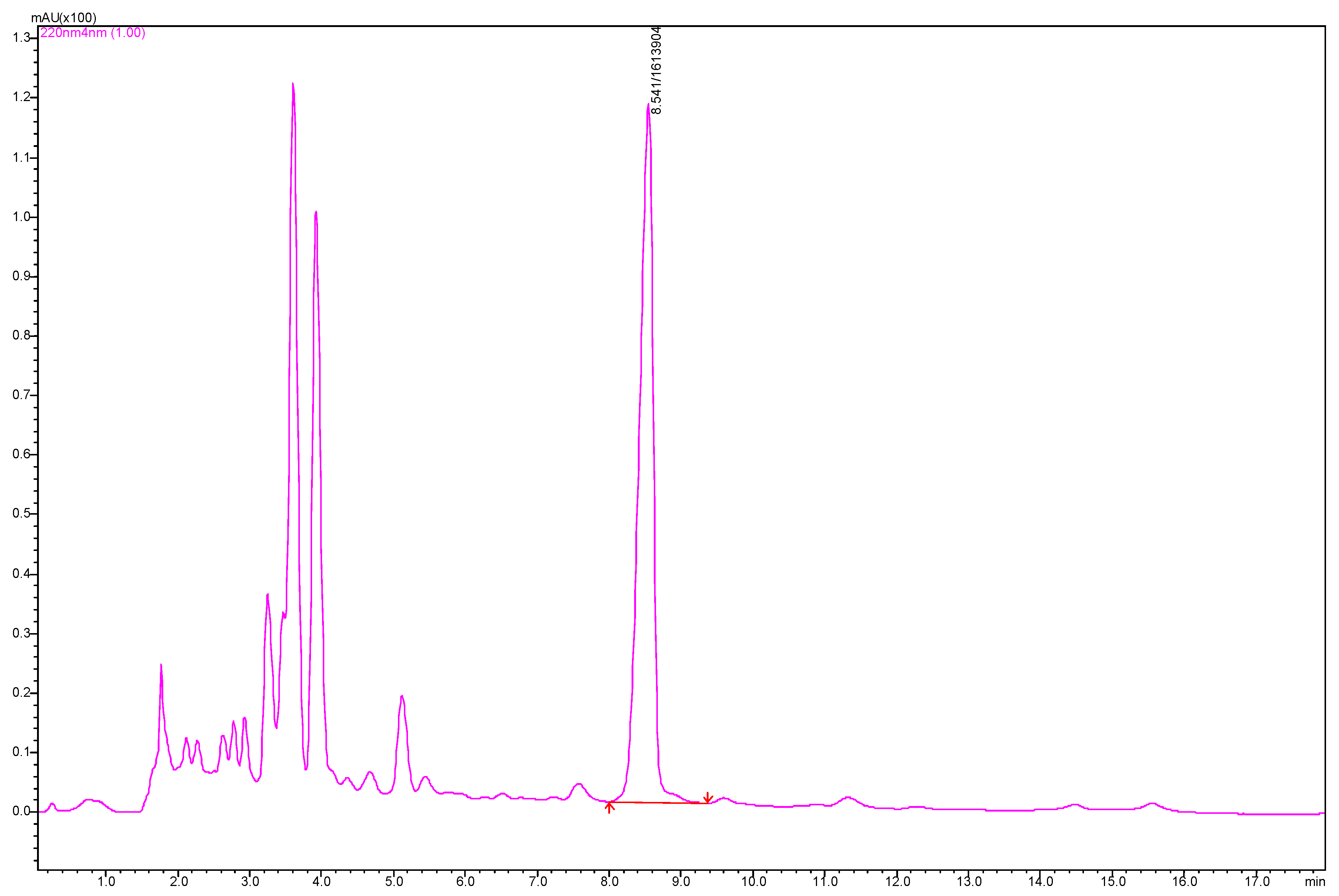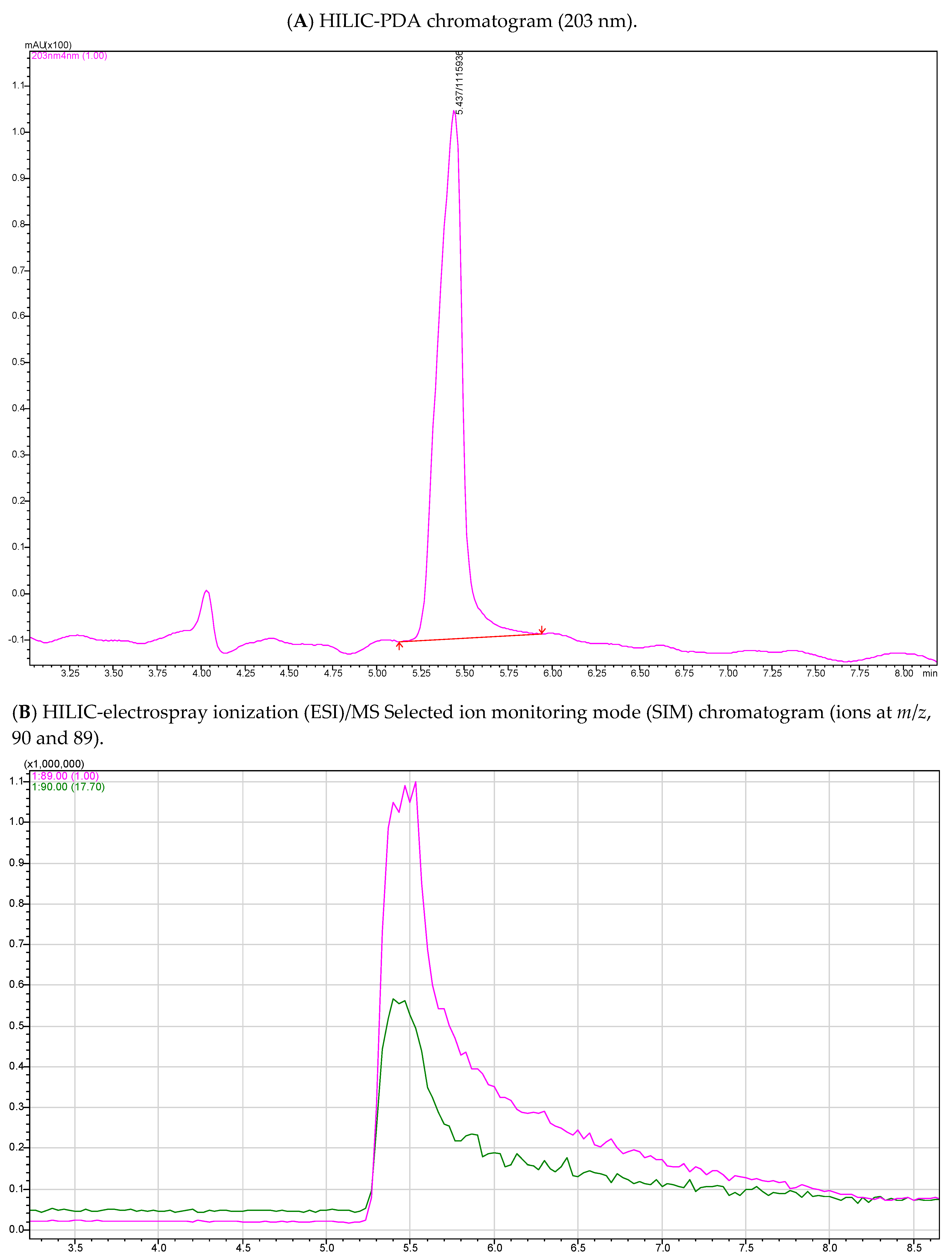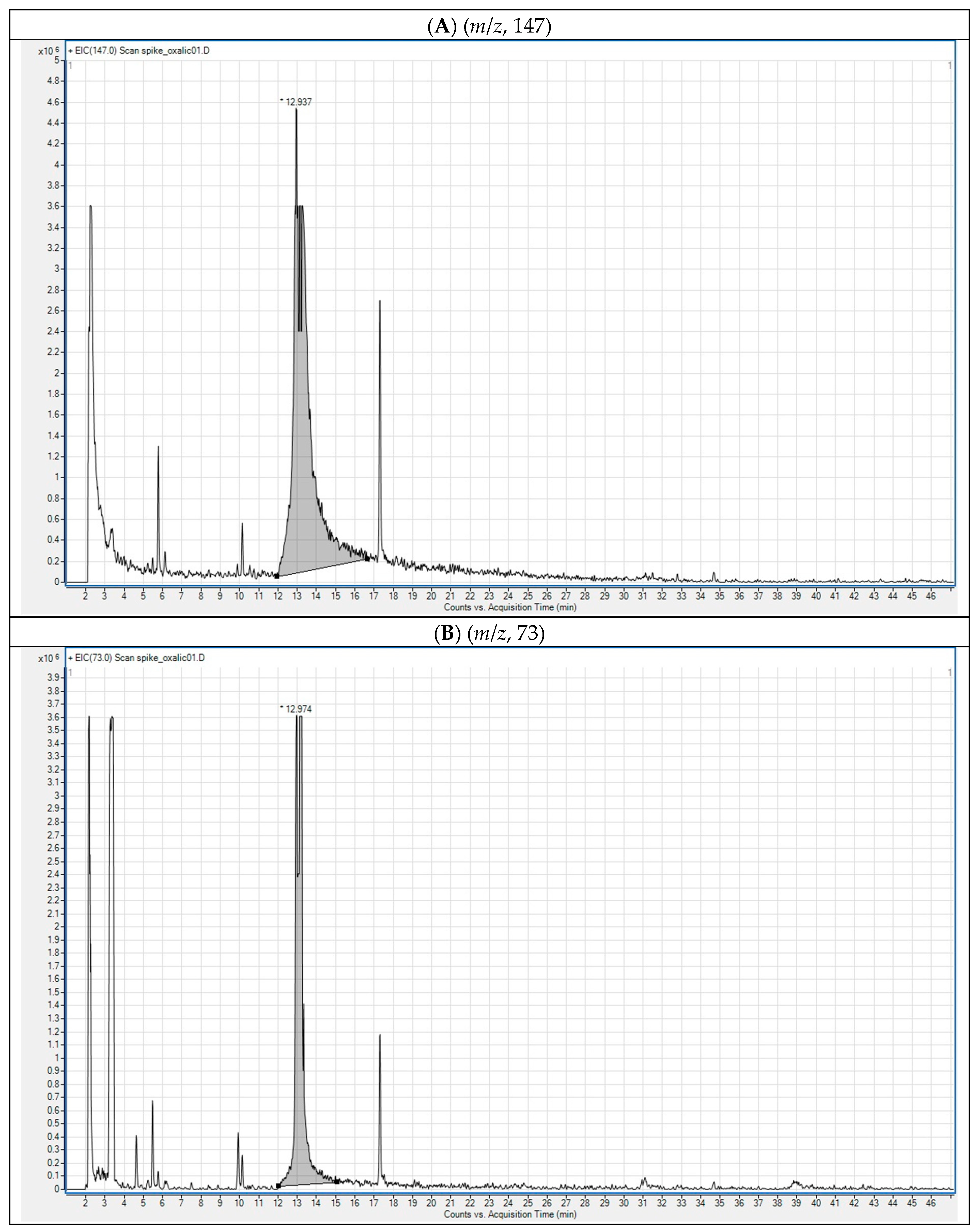A Zwitterionic Hydrophilic Interaction Liquid Chromatographic Photo Diode Array Method as a Tool to Investigate Oxalic Acid in Bees: Comparison with Mass Spectrometric Methods
Abstract
1. Introduction
2. Materials and Methods
2.1. Chemicals
2.2. Stock and Working Standard Solutions
2.3. Sample Preparation for HILIC Analysis
2.4. High-Performance Liquid Chromatography Coupled to Photo Diode Array
2.5. Liquid Chromatography Mass Spectrometry
2.6. Liquid Chromatography Tandem Mass Spectrometry
2.7. GC-MS Derivatization
2.8. Validation of the Present Method
2.9. Statistical Analysis
3. Results and Discussions
3.1. Analytical Method
3.2. Application of the Method to Real Samples
4. Conclusions
Supplementary Materials
Author Contributions
Funding
Conflicts of Interest
References
- Imdorf, A.; Charriere, J.D.; Bachofen, B. De l’utilisation de l’acide oxalique comme varroacide. Apiacta 1997, 32, 89–91. [Google Scholar]
- Coffey, M.F.; Breen, J. The efficacy and tolerability of api-bioxal as a winter varroacide in a cool temperate climate. J. Apicult. Res. 2016, 55, 65–73. [Google Scholar] [CrossRef]
- Maggi, M.; Tourn, E.; Negri, P.; Szawarski, N.; Marconi, A.; Gallez, L.; Medici, S.; Ruffinengo, S.; Brasesco, C.; De Feudis, L.; et al. A new formulation of oxalic acid for varroa destructor control applied in apis mellifera colonies in the presence of brood. Apidologie 2016, 47, 596–605. [Google Scholar] [CrossRef]
- Nanetti, A.; Rodriguez-Garcia, C.; Meana, A.; Martin-Hernandez, R.; Higes, M. Effect of oxalic acid on nosema ceranae infection. Res. Vet. Sci. 2015, 102, 167–172. [Google Scholar] [CrossRef]
- Rademacher, E.; Harz, M.; Schneider, S. Effects of oxalic acid on apis mellifera (hymenoptera: Apidae). Insects 2017, 8, 84. [Google Scholar] [CrossRef]
- Martin-Hernandez, R.; Higes, M.; Perez, J.L.; Nozal, M.J.; Gomez, L.; Meana, A. Short term negative effect of oxalic acid in apis mellifera iberiensis. Span. J. Agric. Res. 2007, 5, 474–480. [Google Scholar] [CrossRef]
- Al Toufailia, H.; Scandian, L.; Ratnieks, F.L.W. Towards integrated control of varroa: 2 comparing application methods and doses of oxalic acid on the mortality of phoretic varroa destructor mites and their honey bee hosts. J. Apicult. Res. 2015, 54, 108–120. [Google Scholar] [CrossRef]
- Higes, M.; Meana, A.; Suarez, M.; Llorente, J. Negative long-term effects on bee colonies treated with oxalic acid against varroa jacobsoni oud. Apidologie 1999, 30, 289–292. [Google Scholar] [CrossRef]
- Charriere, J.D.; Imdorf, A. Nouveaux résultats des essais de traitements à l’acide oxalique par dégouttement. Santé de l’Abeille 1999, 174, 335–343. [Google Scholar]
- Johnson, R.M.; Dahlgren, L.; Siegfried, B.D.; Ellis, M.D. Acaricide, fungicide and drug interactions in honey bees (apis mellifera). PLoS ONE 2013, 8, e54092. [Google Scholar] [CrossRef]
- Nozal, M.J.; Bernal, J.L.; Gomez, L.A.; Higes, M.; Meana, A. Determination of oxalic acid and other organic acids in honey and in some anatomic structures of bees. Apidologie 2003, 34, 181–188. [Google Scholar] [CrossRef]
- Jaitz, L.; Mueller, B.; Koellensperger, G.; Huber, D.; Oburger, E.; Puschenreiter, M.; Hann, S. LC-MS analysis of low molecular weight organic acids derived from root exudation. Anal. Bioanal. Chem. 2011, 400, 2587–2596. [Google Scholar] [CrossRef] [PubMed]
- Zheng, H.; Zhang, Q.; Quan, J.; Zheng, Q.; Xi, W. Determination of sugars, organic acids, aroma componenets, and carotenoids in grapefruit pulps. Food Chem. 2016, 205, 112–121. [Google Scholar] [CrossRef] [PubMed]
- Yang, L.; Yu, L.E. Measurement of oxalic acid, oxalates, malonic acid and malonates in atmospheric paticulates. Environ. Sci. Technol. 2008, 42, 9268–9275. [Google Scholar] [CrossRef] [PubMed]
- Ortega Madueño, I.; Illana Cámara, F.J.; Torrejón Martínez, M.J.; Díaz González, M.C.; Arroyo Fernández, M. Development and validation of an HPLC-MS method for a simultaneous measurement of oxalate and citrate in urine. Rev. Lab. Clin. 2016, 9, 93–97. [Google Scholar] [CrossRef]
- Rademacher, E.; Imdorf, A. Legalization of the use of oxalic acid in varroa control. Bee World 2004, 85, 70–72. [Google Scholar] [CrossRef]
- ICH. Validation of Analytical Procedures: Text and Methodology q2(r1). 2005. Available online: http://www.ich.org/fileadmin/Public_Web_Site/ICH_Products/Guidelines/Quality/Q2_R1/Step4/Q2_R1__Guideline.pdf (accessed on 10 February 2019).
- Danezis, G.P.; Anagnostopoulos, C.J.; Liapis, K.; Koupparis, M.A. Multi-residue analysis of pesticides, plant hormones, veterinary drugs and mycotoxins using hilic chromatography-ms/ms in various food matrices. Anal. Chim. Acta 2016, 942, 121–138. [Google Scholar] [CrossRef]
- Morales-Trejo, F.; Leon, S.V.Y.; Escobar-Medina, A.; Gutierrez-Tolentino, R. Application of high-performance liquid chromatography-uv detection to quantification of clenbuterol in bovine liver samples. J. Food Drug Anal. 2013, 21, 414–420. [Google Scholar] [CrossRef]
- WATERS. Available online: http://www.waters.com/webassets/cms/library/docs/amd09.Pdf (accessed on 20 April 2019).
- Buffer. Available online: https://www.sielc.com/wp-content/uploads/2015/11/sielc_august_2004.Pdf (accessed on 10 May 2019).
- Moldoveanu, S.C.; Poole, T. An LC-MS method for the analysis of some organic acids in tobacco leaf, snus and wet snuff. Beitr. Tabakforsch Int. 2018, 1, 30–41. [Google Scholar] [CrossRef][Green Version]
- SANTE/11813/2017. Guidance Document on Analytical Quality Control and Method Validation Procedures for Pesticides Residues Analysis in Food and Feed; DG Sante, European Commission: Brussels, Belgium, 2017. [Google Scholar]
- Ji, W.; Zhang, Q.; Hu, L. Development of a simple LC-MS assay for determination of regorafenib in rat plasma and its application to a pharmacokinetic study. Lat. Am. J. Pharm. 2014, 33, 607–612. [Google Scholar]
- Sun, J.; Zhang, F.; Peng, Y.; Liu, J.; Zhong, Y.; Wang, G. Quantitative determination of diterpenoid alkaloid Fuziline by hydrophilic interaction liquid chromatography (HILIC)–electrospray ionization mass spectrometry and its application to pharmacokinetic study in rats. J. Chromatogr. B Anal. Technol. Biomed. Life Sci. 2013, 913–914, 55–60. [Google Scholar] [CrossRef] [PubMed]
- Simal-Gandara, J.; Paseiro-Losada, P.; Rodriguez, V.G.; Romero-Rodriguez, A. Comparison of gc-ms and hplc-uv for determination of procymidone in wine. J. Agric. Food Chem. 1993, 41, 674–677. [Google Scholar] [CrossRef]
- Šťávová, J.; Beránek, J.; Nelson, E.P.; Diep, B.A.; Kubátová, A. Limits of detection for the determination of mono- and dicarboxylic acids using gas and liquid chromatographic methods coupled with mass spectrometry. J. Chromatogr. B Anal. Technol. Biomed. Life Sci. 2011, 879, 1429–1438. [Google Scholar] [CrossRef] [PubMed]
- Schriewer, A.; Brink, M.; Gianmoena, K.; Cadenas, C.; Hayen, H. Oxalic acid quantification in mouse urine and primary mouse hepatocyte cell culture samples by ion exclusion chromatography-mass spectrometry. J. Chromatogr. B Anal. Technol. Biomed. Life Sci. 2017, 1068–1069, 239–244. [Google Scholar] [CrossRef] [PubMed]
- Kraus, B.; Berg, S. Effect of a lactic-acid treatment during winter in temperate climate upon varroa-jacobsoni oud and the bee (apis-mellifera l) colony. Exp. Appl. Acarol. 1994, 18, 459–468. [Google Scholar] [CrossRef]
- Kasiotis, K.M.; Tzouganaki, Z.D.; Machera, K. Chromatographic determination of monoterpenes and other acaricides in honeybees: Prevalence and possible synergies. Sci. Total Environ. 2018, 625, 96–105. [Google Scholar] [CrossRef] [PubMed]



| (a ± Sa) | (b ± Sb) | r | LOD (μg/g) | LOQ (μg/g) |
|---|---|---|---|---|
| 5826.8 ± 655.7 | 13546.1 ± 91.8 | 0.99959 | 0.48 | 1.46 |
| Samples | Spiking level (μg/g) | Recovery % ± RSD, n = 3 | Repeatability | |
| Intra-d (RSD%) | Inter-d (RSD%) | |||
| Honeybees | 1 | 88.9 ± 12.5 | 8.2 | 10.4 |
| 10 | 91.4 ± 9.2 | 6.9 | 9.2 | |
| 100 | 83.2 ± 5.9 | 6.3 | 5.9 | |
© 2019 by the authors. Licensee MDPI, Basel, Switzerland. This article is an open access article distributed under the terms and conditions of the Creative Commons Attribution (CC BY) license (http://creativecommons.org/licenses/by/4.0/).
Share and Cite
Kasiotis, K.M.; Manea-Karga, E.; Machera, K. A Zwitterionic Hydrophilic Interaction Liquid Chromatographic Photo Diode Array Method as a Tool to Investigate Oxalic Acid in Bees: Comparison with Mass Spectrometric Methods. Separations 2019, 6, 48. https://doi.org/10.3390/separations6040048
Kasiotis KM, Manea-Karga E, Machera K. A Zwitterionic Hydrophilic Interaction Liquid Chromatographic Photo Diode Array Method as a Tool to Investigate Oxalic Acid in Bees: Comparison with Mass Spectrometric Methods. Separations. 2019; 6(4):48. https://doi.org/10.3390/separations6040048
Chicago/Turabian StyleKasiotis, Konstantinos M., Electra Manea-Karga, and Kyriaki Machera. 2019. "A Zwitterionic Hydrophilic Interaction Liquid Chromatographic Photo Diode Array Method as a Tool to Investigate Oxalic Acid in Bees: Comparison with Mass Spectrometric Methods" Separations 6, no. 4: 48. https://doi.org/10.3390/separations6040048
APA StyleKasiotis, K. M., Manea-Karga, E., & Machera, K. (2019). A Zwitterionic Hydrophilic Interaction Liquid Chromatographic Photo Diode Array Method as a Tool to Investigate Oxalic Acid in Bees: Comparison with Mass Spectrometric Methods. Separations, 6(4), 48. https://doi.org/10.3390/separations6040048





